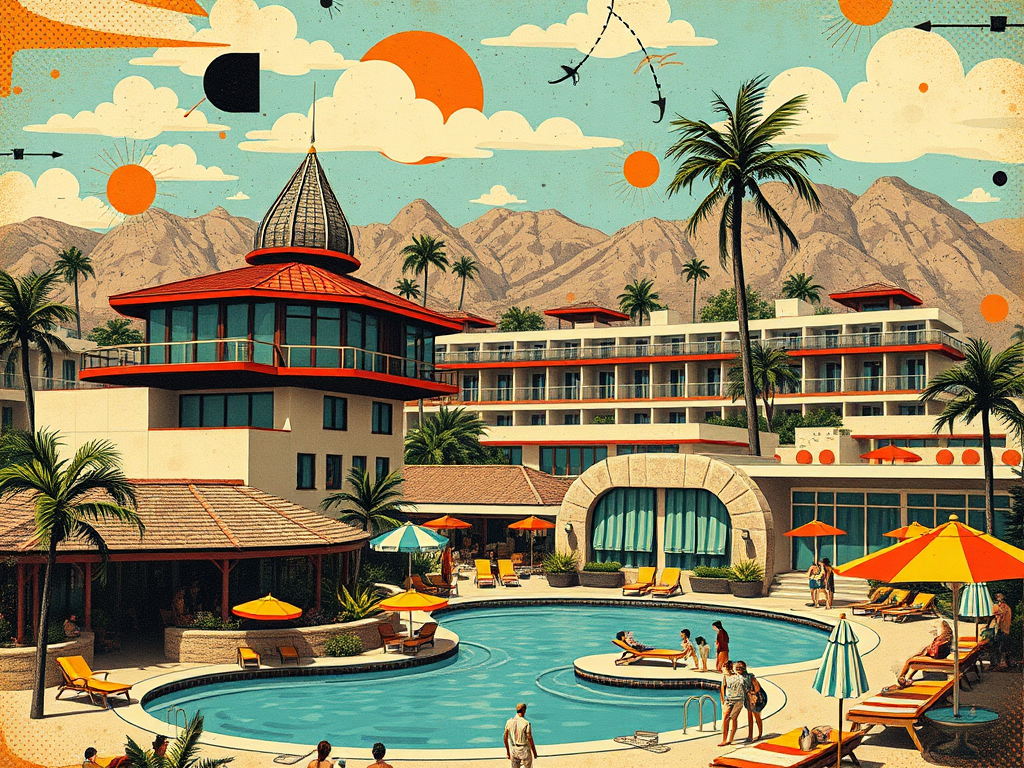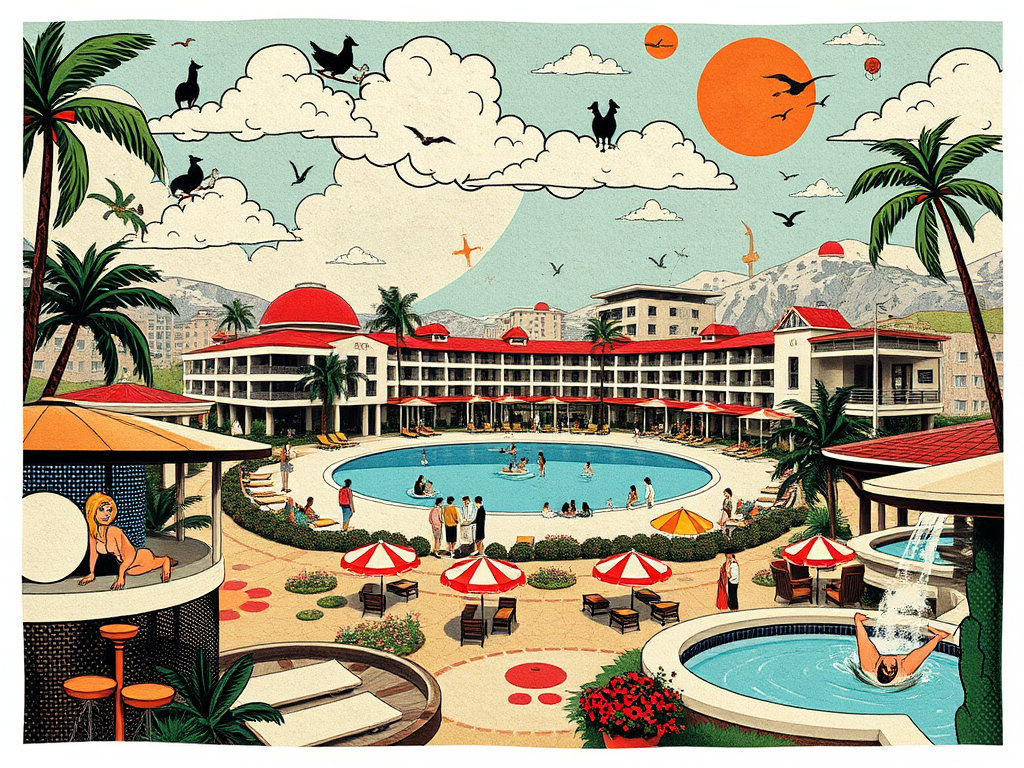
High-End Tourism: The Rise of Luxury Resorts, Spas, and Retreats
Reading time: 15 minutes
Table of Contents
- Introduction
- The Evolution of Luxury Tourism
- Key Drivers of High-End Tourism Growth
- Luxury Resorts: Redefining Opulence
- Exclusive Spas: The Pinnacle of Relaxation
- Wellness Retreats: Holistic Luxury
- Economic Impact of High-End Tourism
- Sustainability in Luxury Tourism
- The Future of High-End Tourism
- Conclusion
- FAQs
1. Introduction
The landscape of global tourism has undergone a significant transformation in recent years, with a notable shift towards high-end experiences. Luxury resorts, exclusive spas, and wellness retreats have emerged as the new frontiers of opulent travel, catering to a discerning clientele seeking unparalleled comfort, personalized service, and transformative experiences. This article delves into the economic dynamics driving this trend, exploring the intricate interplay between consumer preferences, market forces, and the evolving definition of luxury in the tourism sector.
2. The Evolution of Luxury Tourism
Luxury tourism has come a long way from its traditional associations with ornate hotels and first-class flights. Today’s high-end travelers are increasingly seeking experiences that go beyond material opulence, valuing authenticity, exclusivity, and personal growth. This shift has led to a reimagining of luxury offerings in the tourism industry, with a focus on creating unique, memorable experiences that cater to individual preferences and aspirations.
Historical Perspective
The concept of luxury travel can be traced back to the grand tours of the 17th and 18th centuries, where wealthy Europeans embarked on extended journeys to broaden their cultural horizons. Over time, luxury tourism evolved to encompass high-end accommodations, gourmet dining, and exclusive entertainment. However, the 21st century has ushered in a new era of luxury travel, characterized by a desire for transformative experiences, cultural immersion, and personal well-being.
3. Key Drivers of High-End Tourism Growth
Several factors have contributed to the burgeoning growth of high-end tourism:
- Rising global wealth: The increasing number of high-net-worth individuals (HNWIs) has created a larger market for luxury travel experiences.
- Changing consumer preferences: Modern luxury travelers prioritize unique experiences, personalization, and authenticity over traditional status symbols.
- Technological advancements: Digital platforms have made it easier for travelers to discover and book exclusive experiences, while also enabling personalized service delivery.
- Emphasis on well-being: The growing focus on health and wellness has fueled demand for high-end spa and retreat experiences.
- Desire for exclusivity: Affluent travelers are increasingly seeking out secluded, private destinations away from mass tourism.
4. Luxury Resorts: Redefining Opulence
Luxury resorts have evolved to become more than just lavish accommodations. They now offer immersive experiences that cater to every aspect of a traveler’s desires. From private islands in the Maldives to eco-lodges in the Amazon rainforest, these resorts combine stunning natural settings with world-class amenities and personalized service.
Key Features of Modern Luxury Resorts
- Bespoke experiences: Tailored activities and itineraries designed to meet individual preferences.
- Cutting-edge technology: Smart room controls, virtual concierges, and AI-powered personalization.
- Culinary excellence: Michelin-starred restaurants, farm-to-table concepts, and personalized dining experiences.
- Sustainable practices: Eco-friendly operations, local community engagement, and conservation efforts.
- Exclusive access: Private beaches, helicopter transfers, and VIP experiences at local attractions.
5. Exclusive Spas: The Pinnacle of Relaxation
Luxury spas have become integral components of high-end tourism, offering travelers a sanctuary for relaxation, rejuvenation, and self-care. These exclusive retreats combine ancient healing traditions with cutting-edge wellness technologies to provide transformative experiences.
Trends in Luxury Spa Offerings
- Personalized wellness programs: Tailored treatments based on individual health assessments and goals.
- Advanced therapies: Cryotherapy, DNA-based skincare, and neuroscience-informed relaxation techniques.
- Holistic approaches: Integration of mental, physical, and spiritual well-being practices.
- Cultural immersion: Spa treatments inspired by local traditions and using indigenous ingredients.
- Technological integration: Virtual reality relaxation, biomarker tracking, and AI-powered treatment recommendations.
6. Wellness Retreats: Holistic Luxury
Wellness retreats represent the convergence of luxury hospitality and holistic health practices. These immersive experiences offer travelers the opportunity to focus on their well-being in serene, exclusive settings. From meditation retreats in the Himalayas to fitness boot camps in the Caribbean, wellness tourism caters to a wide range of health-conscious luxury travelers.
Popular Wellness Retreat Concepts
- Mindfulness and meditation: Silent retreats, guided meditation programs, and mindfulness workshops.
- Fitness and adventure: High-intensity training camps, yoga retreats, and adventure wellness experiences.
- Detox and cleansing: Juice fasts, cleansing programs, and specialized nutrition plans.
- Medical wellness: Executive health check-ups, preventive medicine programs, and anti-aging treatments.
- Emotional healing: Psychotherapy-based retreats, grief counseling, and stress management programs.
7. Economic Impact of High-End Tourism
The rise of luxury resorts, spas, and retreats has had a significant economic impact on both local and global scales. This segment of the tourism industry generates substantial revenue, creates high-value jobs, and stimulates economic development in destination regions.
Key Economic Indicators
- Revenue generation: Luxury travelers tend to spend 5-10 times more than average tourists, contributing disproportionately to tourism revenue.
- Employment creation: High-end tourism facilities require skilled staff, creating well-paying jobs in hospitality, wellness, and related sectors.
- Infrastructure development: The establishment of luxury resorts often leads to improvements in local infrastructure, benefiting the broader community.
- Multiplier effect: Luxury tourism spending has a ripple effect on local economies, supporting ancillary businesses and services.
- Foreign investment: The potential for high returns attracts foreign investment in luxury tourism projects, stimulating economic growth.
8. Sustainability in Luxury Tourism
As environmental consciousness grows among affluent travelers, sustainability has become a crucial aspect of high-end tourism. Luxury resorts, spas, and retreats are increasingly adopting eco-friendly practices and contributing to conservation efforts.
Sustainable Practices in Luxury Tourism
- Energy efficiency: Use of renewable energy sources, smart energy management systems, and carbon offset programs.
- Water conservation: Implementation of water recycling systems, rainwater harvesting, and low-flow fixtures.
- Waste reduction: Zero-waste initiatives, plastic-free policies, and composting programs.
- Local sourcing: Procurement of food and materials from local suppliers to reduce carbon footprint and support local economies.
- Conservation efforts: Participation in wildlife protection, reef restoration, and forest conservation projects.
9. The Future of High-End Tourism
The future of high-end tourism is likely to be shaped by several emerging trends and technologies:
- Space tourism: As commercial space travel becomes a reality, ultra-luxury experiences may extend beyond Earth’s atmosphere.
- Virtual and augmented reality: Immersive technologies could enhance luxury travel experiences and enable virtual previews of destinations.
- Personalization through AI: Artificial intelligence will enable even more tailored experiences, predicting traveler preferences with unprecedented accuracy.
- Wellness integration: Health and wellness considerations will become increasingly central to all aspects of luxury travel.
- Experiential luxury: The focus will continue to shift from material opulence to unique, transformative experiences.
The luxury real estate market is closely tied to high-end tourism trends. For those interested in combining luxury travel with property investment, exploring options for property for sale greece can provide insights into how tourism trends influence real estate markets in popular destinations.
10. Conclusion
The rise of luxury resorts, spas, and retreats represents a significant shift in the tourism industry, reflecting changing consumer preferences and evolving definitions of luxury. This trend has had a substantial economic impact, driving revenue growth, job creation, and infrastructure development in destination regions. As the sector continues to evolve, sustainability and personalization will likely play increasingly important roles in shaping the future of high-end tourism.
The economic dynamics of high-end tourism underscore its importance as a driver of growth and innovation in the broader travel industry. As luxury travelers continue to seek out unique, transformative experiences, the sector is poised for continued expansion and evolution. This presents both opportunities and challenges for destinations, investors, and service providers in the luxury tourism ecosystem.
Ultimately, the success of high-end tourism will depend on the industry’s ability to balance opulence with authenticity, technological innovation with personal touch, and luxury with sustainability. As the sector navigates these challenges, it will continue to push the boundaries of what’s possible in travel experiences, setting new standards for luxury and redefining the concept of high-end tourism for future generations.
FAQs
-
What defines a luxury resort in today’s tourism landscape?
A luxury resort in today’s context goes beyond opulent accommodations. It typically offers personalized experiences, exclusive amenities, world-class dining, cutting-edge wellness facilities, and often incorporates elements of sustainability and cultural immersion. The focus is on creating unique, memorable experiences tailored to individual preferences.
-
How has the concept of wellness tourism evolved in the luxury sector?
Wellness tourism in the luxury sector has evolved from simple spa treatments to comprehensive, holistic approaches to well-being. It now encompasses personalized fitness programs, nutrition plans, mental health therapies, and even medical-grade health assessments. Luxury wellness retreats often combine traditional healing practices with cutting-edge medical technologies.
-
What role does technology play in modern luxury tourism?
Technology plays a crucial role in enhancing the luxury travel experience. This includes AI-powered personalization, smart room controls, virtual reality experiences, and advanced booking platforms. Technology is also used to improve sustainability efforts and streamline operations behind the scenes, ensuring a seamless guest experience.
-
How are luxury resorts addressing sustainability concerns?
Luxury resorts are increasingly adopting sustainable practices such as using renewable energy sources, implementing water conservation measures, reducing waste, sourcing locally, and participating in conservation efforts. Many are also educating guests about sustainability and involving them in eco-friendly initiatives during their stay.
-
What economic impact does high-end tourism have on local communities?
High-end tourism can have a significant positive economic impact on local communities. It creates high-value jobs, stimulates infrastructure development, attracts foreign investment, and has a multiplier effect on local economies. However, it’s crucial for this development to be managed sustainably to ensure long-term benefits for local populations and environments.

Article reviewed by Liina Tamm, Real Estate and Investment Expert | Consultant for Commercial and Residential Properties | Market Analysis and Strategies for International Investors, on March 25, 2025
